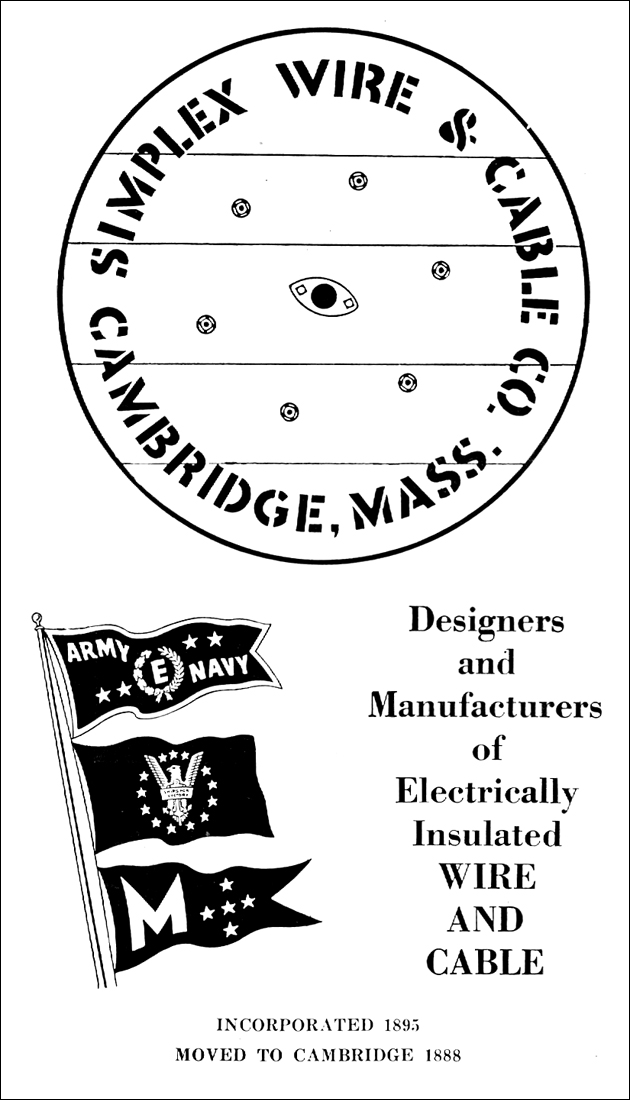SIMPLEX WIRE & CABLE
The Simplex Wire & Cable Company, while not formed until the late nineteenth century, had its origins in a firm founded five decades earlier. Indeed, Charles A. Morss and Oliver Whyte originally established the company of Morss & Whyte in Boston in 1842 (Stone, 1930). The business was primarily engaged in the manufacturing of various steel-wire products, including fire screens, wire cloths, and birdcages. By 1845 – with the retirement of Whyte – Morss became the primary and active partner of the firm and by 1868 functioned as the sole owner. In 1885, following a fire at its original plant, the company was moved from its Boston location to a factory on Franklin Street in Cambridge (Stone, 1930; Gale Group, 1998.). During this time, Morss began to experiment with the production of insulated wire. Although Morss initially experienced several failures in his attempt to design an anti-induction telephone cable, by the end of 1885, he had managed to produce a mile of specialized wire known as TZR. This wire, which was used to power street lamps in Boston, was an enormous success and resulted in the establishment of an electrical-wire division of the company. By 1890, the production of electrical wire and cables became the primary business of Morss & Whyte (Stone, 1930; Gale Group, 1998.). In response, the firm purchased the Simplex Electrical Company, which had originally been formed for the purpose of selling Morss & Whyte’s TZR wire. In 1895, the business of Morss & Whyte was wholly replaced with the newly incorporated Simplex Wire & Cable Company. The new company operated within the Morss & Whyte factory, producing insulated wires and cables intended for electrical uses (Gale Group, 1998.; Glover, 2009).
By the turn of the century, Simplex had emerged as one of the largest and most recognizable companies in the City of Cambridge. As of 1930, the firm employed over 750 workers and had a capital of $1,200,000 (Stone, 1930). During this time period, the company engaged in a relentless physical expansion of its production facilities, occupying not simply the original Franklin Street site, but also several blocks surrounding the site (Cambridge Historical Society, 1971). Likewise, throughout the twentieth century, Simplex continued to function as an innovator in the field of electrical wires and cables. In 1900, for instance, the company was responsible for laying a groundbreaking five-mile stretch of underwater cable in Lake Michigan. Similarly, in the 1920s, Simplex was a pioneer in the research and development of a protein-free rubber that significantly extended the lifespan of submarine cables. During World War II, the company produced and laid thousands of miles of cable for the US Army Signal Corps Alaskan Communication System and for other coastal defense projects. Following the war, the company opened up an additional plant in Newington, New Hampshire in order to meet product demands and contracts for various governmental bodies (Glover, 2009; Gale Group, 1998.).
By the 1960s, Simplex employed approximately 1,100 hands and had built the last expansion to its Cambridge warehouse, an addition that occupied three city blocks between Brookline and Sidney Streets. In 1969, the firm was sold to a New York-based corporation and production was moved to a newer facility in North Berwich, Maine (Cambridge Historical Society, 1971; Sandler, 1971). The Cambridge site of the original Simplex factory was purchased by MIT in July of 1969 and many of the buildings were demolished by the 1970s (Sandler, 1971).
